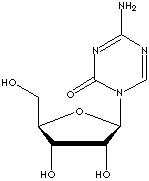PRODUCT IDENTIFICATION

206-280-2
H.S. CODE
TOXICITY
CLASSIFICATION
PHYSICAL AND CHEMICAL PROPERTIES
AUTOIGNITION
NFPA RATINGS
REFRACTIVE INDEX
GENERAL DESCRIPTION AND APPLICATIONS
Cytosine is a pyrimidine base, occurring condensed with ribose or deoxyribose to form the nucleosides cytidine and deoxycytidine in animal cells. It is a fundamental unit or base of nucleic acids. When N9 is linked to the C1 of ribose, cytosine forms a pyrimidine nucleoside called cytidines which are phosphorylated with from one to three phosphoric acid groups to form the three nucleotides; cytidine monophosphate (CMP), cytidine diphosphate (CDP), and cytidine triphosphate (TTP) respectively. When N1 is linked to the C1 of deoxyribose, deoxy nucleosides and nucleotides are formed from cytosine and deoxyribose; deoxycytidine monophosphate (dCMP), deoxycytidine diphosphate (dCDP), deoxycytidine triphosphate (dCTP). CTP is the source of the cytidine in RNA (ribonucleic acid) and deoxycytidine triphosphate (dCTP) is the source of the deoxycytidine in DNA (deoxyribonucleic acid). CTP is involved in the formation of adenosine triphosphate (ATP) as a donator of phosphate groups to adenosine diphosphate (ADP).
- Cytidine Monophosphate (CMP, Cytidylic Acid; ): a nucleotide, the 5'-phosphate of cytidine, acting as a carrier of N-acetylneuraminic acid in glycoprotein synthesis.
- Cytidine Diphosphate (CDP): a nucleotide, the 5'-pyrophosphate of cytidine, acting as a carrier of choline and ethanolamine in the phospholipid synthesis.
- Cytidine Triphosphate (CTP): a nucleotide, the 5'-triphosphate of cytidine; precursor in the synthesis of ribonucleic acid and of CDP- and CMP-linked compounds.
- Deoxycytidine Monophosphate (dCMP): a nucleotide, the 5'-phosphate of deoxycytidine (deoxy-, also called desoxy, is a prefix for the designation of compounds which contain one less atom of oxygen than the reference substance).
- Deoxycytidine Diphosphate (dCDP): a nucleotide, the 5'-pyrophosphate of deoxycytidine.
- Deoxycytidine Triphosphate (dCTP): a nucleotide, the 5'-triphosphate of deoxycytidine; an precursor in the synthesis of DNA.
Chemically modified nucleotides substituted or attached by special chemical groups or elements are studied and used to inactivate the normal biological operation in the living organism and the function of important enzymes.
APPEARANCE
98.0 - 102.0%
OPTICAL ROTATION
+39° ~ +41° (C=1 , H2O)
HEAVY METALS
10ppm max
0.5% max